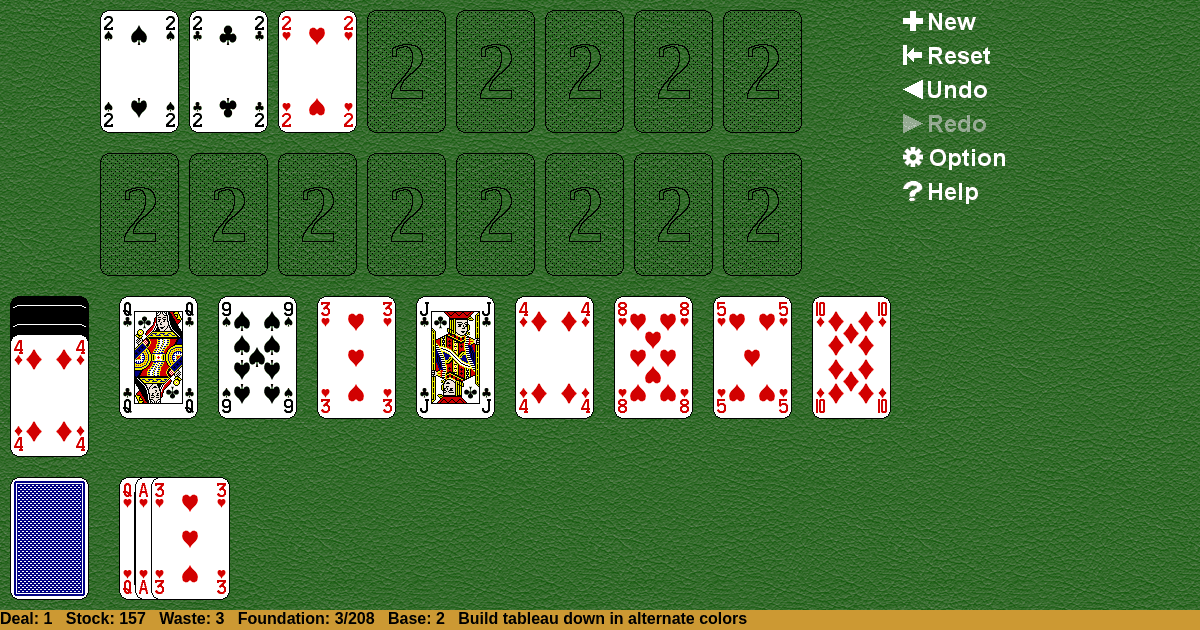Quadruple Canfield
Home |
How to play |
FAQ |
About
How to play Quadruple Canfield?
Game Objective:
The primary goal in Quadruple Canfield Solitaire is to move all 208 cards (using four standard 52-card decks) to the foundation piles, building each foundation up by suit starting from the base card assigned to that pile.
Setup & Layout:
- Decks Used: Four standard 52-card decks, totaling 208 cards.
- Reserve: One reserve pile is created by dealing 39 cards; the top card is dealt face-up, while the remaining 38 are face-down.
- Foundations: There are 16 foundation piles (one for each suit in four decks). Each foundation pile starts with a base card when it becomes available, and is built up by suit.
- Tableau: The tableau consists of eight piles. Each pile is dealt one card face-up at the start of the game.
- Stock: The remaining cards after the reserve, tableau, and foundations are set aside as the stock pile, placed face-down.
- Waste: Cards drawn from the stock are placed face-up onto the waste pile, with only the top card available for play.
Play Area Definitions:
- Reserve: A pile of 39 cards, only the top card is accessible at any time.
- Foundations: Sixteen piles, one for each suit, built up in ascending order by suit.
- Tableau: Eight piles where cards are arranged in descending order and alternating colors.
- Stock: The draw pile, face-down.
- Waste: Discard pile, face-up; only the top card is playable.
Quadruple Canfield Solitaire Rules:
- Building Foundations: Foundations are built up by suit, starting from the base card (which may not be an Ace), wrapping around from King to Ace as needed.
- Tableau Building: Cards in the tableau are built in descending order and must alternate colors (red/black). Sequences may wrap from Ace to King.
- Card Movement:
- Only the top card of the reserve, tableau piles, or waste pile may be moved.
- Cards (or sequences) can be moved between tableau piles if they follow descending order and alternating colors.
- Only the top card of the reserve is available for play; when it is moved, the next card beneath is turned face-up.
- When a tableau pile is empty, it must be filled immediately with the top card of the reserve. If the reserve is empty, the top card of the waste pile is used.
- Stock/Waste Interaction: Cards are drawn from the stock, typically in groups (often three at a time), and placed on the waste pile. Only the top card of the waste pile is playable.
Gameplay:
- Turn Sequence:
- Play any available card from the reserve, tableau, or waste pile to the foundations if possible.
- Build tableau piles by moving cards or legal sequences, following descending order and alternating colors.
- Draw cards from the stock to the waste pile when no other moves are available. Only the top card of the waste may be played to tableau or foundations.
- Fill empty tableau spaces immediately with the top card of the reserve; if the reserve is depleted, use the top card of the waste pile.
- Introducing New Cards:
- When the reserve's top card is played, flip the next reserve card face-up.
- When the stock is depleted, the waste pile may be turned over to become the new stock (rules may vary on the number of redeals allowed).
- No More Legal Moves:
- If no moves are possible from reserve, tableau, or waste, and the stock is exhausted, the game ends in a standstill.
Winning & Losing Conditions:
- Winning: The game is won when all 208 cards are moved to the foundation piles, correctly built up by suit from the base card.
- Losing/Unwinnable: The game is lost or unwinnable if no legal moves remain and the stock and reserve are exhausted, leaving cards stranded in the tableau or waste.
Special Rules & Edge Cases:
- Filling Empty Tableau Spaces: An empty tableau pile must be filled immediately with the top card of the reserve. If the reserve is empty, use the top card of the waste pile.
- Base Card Wrapping: Foundations and tableau sequences may wrap from King to Ace, continuing the sequence as needed.
- Reserve Access: Only the top card of the reserve is accessible; when played, the next card is revealed.
- Redeals: The number of times the waste pile can be recycled into the stock may be limited depending on specific house rules or platform implementation.
- Multiple Decks: With four decks, there are sixteen foundation piles and a much larger tableau and reserve, making the game significantly more complex than standard Canfield.
Definitions of Key Terms:
- Reserve: A pile of face-down cards with only the top card face-up and available for play.
- Foundation: A pile built up by suit starting from a base card, wrapping around as necessary.
- Tableau: The primary play area where cards are arranged in descending order and alternating colors.
- Stock: The face-down draw pile.
- Waste: The face-up discard pile, with only the top card available for play.
This guide is based on the most authoritative available sources for Quadruple Canfield Solitaire, prioritizing official and rule-focused documentation.

Solitaire Collection
About Quadruple Canfield
Rate (Quadruple Canfield)
4.7 / 5
1,916 votes



























































